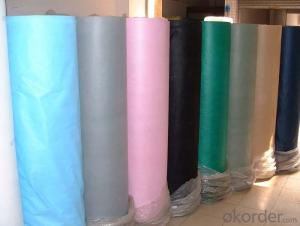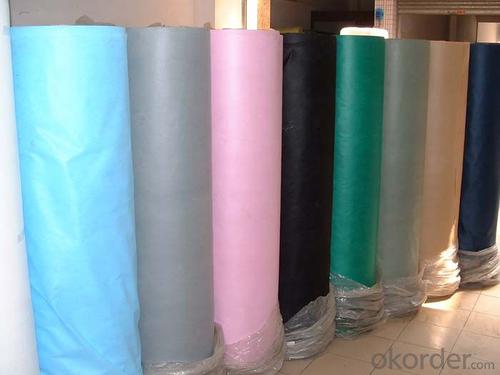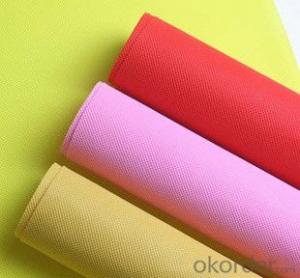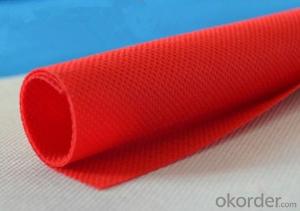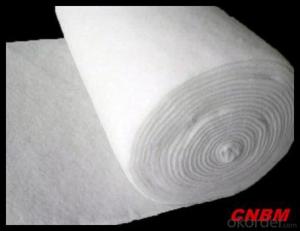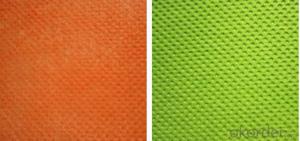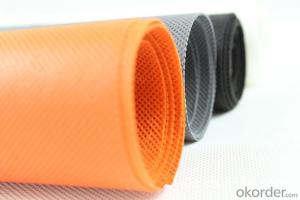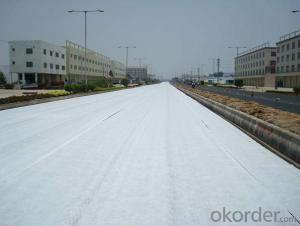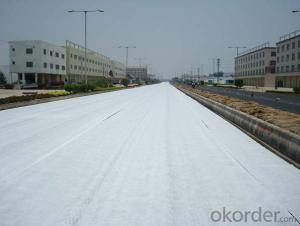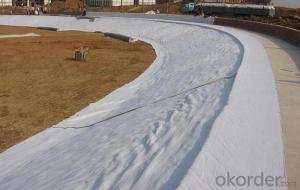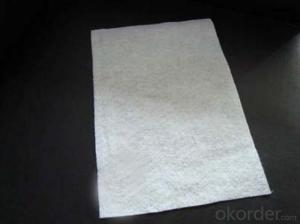Geotextile 300gr PP Spunbonded Nonwoven Fabric Good Quality with UV 8%
- Loading Port:
- China Main Port
- Payment Terms:
- TT OR LC
- Min Order Qty:
- -
- Supply Capability:
- -
OKorder Service Pledge
OKorder Financial Service
You Might Also Like
1.What is your main products ?
Our main products are made from PE ,PP etc and could be used for agriculture and construction ,etc .
2.What is your payment term ?
We could accept TT ,LC.
3.What is your delivery time ?
The delivery time is around 30days per container, sometimes we have stocks .
pp spunbonded nonwoven fabric
The specification of PP non woven fabric in different color and many applications:
| | |
Material | 100% Polypropylene/100%PP |
Width | 0.4--3.2M |
Color | Any color available |
Roll Length | According to your requirement |
Technics | Nonwoven |
Nonwoven Technics | Spunbonded |
Pattern | Yarn Dyed |
Weight | 9-200GSM |
Style | Plain |
Feature | Waterproof,Mothproof,Eco-friendly,Non-toxic,Breathable,Anti-Bacteria |
Certification | ISO9001 |
Usage | Agriculture,Indrustry,Construction,Packaging,Home-textitle, etc |
MOQ | 1Ton/1000KG |
Payment Terms | T/T or L/C |
Delivery Time | Within 7-15 days |
Packaging Detail | Plastic film in roll |
| Shandong,China |
Loading of Port | Qingdao |
Sample | Free samples are available |
Delivery Time
Within 7-15 days after 30% deposit is received or L/C
Payment Terms
1) T/T: 30% T/T in advance and balance 70% before shipping B/L copy
- Q: What are the different factors that affect the performance of geotextiles?
- There are several factors that can affect the performance of geotextiles. These include the type and quality of the material used in the geotextile, its thickness, weight, and strength. The installation technique and conditions, such as the soil type and slope, also play a significant role. Environmental factors, such as temperature, moisture, and chemical exposure, can impact the durability and effectiveness of geotextiles. Additionally, the design and engineering considerations, including the intended application and load requirements, should be taken into account when evaluating the performance of geotextiles.
- Q: Are geotextiles suitable for use in geocell mattress systems?
- Yes, geotextiles are suitable for use in geocell mattress systems. Geotextiles have excellent filtration and separation properties, which help in preventing soil erosion and maintaining stability within the geocell system. They also provide reinforcement and allow for the proper drainage of water, making them an ideal choice for use in geocell mattress systems.
- Q: What are the cost implications of using geotextiles in construction projects?
- The cost implications of using geotextiles in construction projects can vary depending on factors such as the type and quality of the geotextile, the size and complexity of the project, and the specific requirements of the site. Generally, geotextiles can add an additional cost to the project due to the cost of the material itself, installation, and any necessary testing or inspections. However, these costs can often be offset by the benefits provided by geotextiles, such as increased durability, improved soil stability, reduced long-term maintenance, and potential savings in material and labor costs. Ultimately, a thorough cost-benefit analysis should be conducted to determine the overall financial implications of using geotextiles in a construction project.
- Q: What are the specifications for geotextiles in landfill liner applications?
- The specifications for geotextiles in landfill liner applications typically include factors such as the material's tensile strength, puncture resistance, permeability, and ability to withstand chemical exposure. These geotextiles must meet certain standards to ensure effective containment and environmental protection in landfill projects.
- Q: How do geotextiles improve the performance of geocomposites?
- Geotextiles improve the performance of geocomposites by enhancing their strength, durability, and filtration capabilities. They act as a reinforcement layer, distributing the load and preventing the geocomposite from shifting or deforming under stress. Additionally, geotextiles provide filtration, allowing water to flow through while retaining soil particles, which helps in preventing clogging and maintaining the long-term performance of the geocomposite.
- Q: Filter geotextile, permeable geotextile, seepage geotextile What is the difference?
- The above three products are a product. But is divided into polypropylene staple acupuncture geotextile, polyester staple acupuncture geotextile, filament geotextile. Three categories. Play a major role is good permeability, filtration, isolation performance, construction convenience.
- Q: What are the installation guidelines for geotextiles used in erosion control blankets?
- The installation guidelines for geotextiles used in erosion control blankets typically involve the following steps: 1. Site preparation: Ensure that the area where the erosion control blanket will be installed is properly graded and free of any debris or vegetation. 2. Unroll the geotextile: Start by unrolling the geotextile fabric along the slope or area where erosion control is needed. Make sure to overlap the fabric by the specified amount to ensure complete coverage. 3. Secure the fabric: Use stakes or landscape pins to secure the geotextile to the ground, especially at the edges and corners. This will prevent it from shifting or being displaced during installation or heavy rainfall. 4. Seam connection: If multiple rolls of geotextile fabric are required, ensure that they are properly overlapped and securely connected using a recommended seam connection method. This will ensure a continuous and seamless coverage. 5. Anchoring: In certain cases, additional anchoring may be required to provide extra stability. This can include using sandbags, rocks, or other suitable materials along the edges or across the surface of the geotextile fabric. 6. Vegetative cover: If the erosion control blanket is designed to support vegetation growth, follow the recommended guidelines for seed or plant installation. This may involve spreading seeds or planting live vegetation through the geotextile fabric. It is important to note that these guidelines may vary depending on the specific erosion control blanket and geotextile manufacturer, as well as the site and project requirements. It is always recommended to refer to the manufacturer's installation instructions and consult with a professional engineer or erosion control specialist for proper installation and best results.
- Q: How are geotextiles different from other geosynthetic materials?
- Geotextiles are a type of geosynthetic material that is specifically designed to provide filtration, separation, and reinforcement functions in civil engineering projects. Unlike other geosynthetic materials such as geogrids or geomembranes, geotextiles are primarily used for their filtration properties, allowing water to pass through while retaining soil particles. They are typically made from synthetic fibers, which give them high tensile strength and durability. Overall, geotextiles serve a distinct purpose within geosynthetic materials, focusing on filtration and soil stabilization applications.
- Q: What are the key considerations for geotextile installation in areas prone to landslides?
- The key considerations for geotextile installation in areas prone to landslides include: 1. Site evaluation: Conduct a thorough assessment of the site to understand the slope stability, soil conditions, and potential triggers for landslides. This will help determine the appropriate type and strength of geotextile needed. 2. Design and engineering: Engage geotechnical engineers to design a tailored solution based on the specific needs of the site. They will consider factors such as slope gradient, soil type, and expected loads to determine the appropriate geotextile specifications. 3. Drainage management: Proper drainage is critical to prevent water accumulation, which can increase the risk of landslides. Geotextiles can be used to enhance drainage by allowing water to pass through while retaining soil particles. 4. Anchoring and securing: Geotextiles should be securely anchored to the slope to ensure stability. This may involve using appropriate anchor systems or integrating the geotextile into the existing slope or retaining structure. 5. Monitoring and maintenance: Regular monitoring is essential to identify any signs of distress or movement in the slope. Timely maintenance and repair of the geotextile system can help prevent potential failures and ensure its long-term effectiveness in landslide-prone areas.
Send your message to us
Geotextile 300gr PP Spunbonded Nonwoven Fabric Good Quality with UV 8%
- Loading Port:
- China Main Port
- Payment Terms:
- TT OR LC
- Min Order Qty:
- -
- Supply Capability:
- -
OKorder Service Pledge
OKorder Financial Service
Similar products
Hot products
Hot Searches
Related keywords
